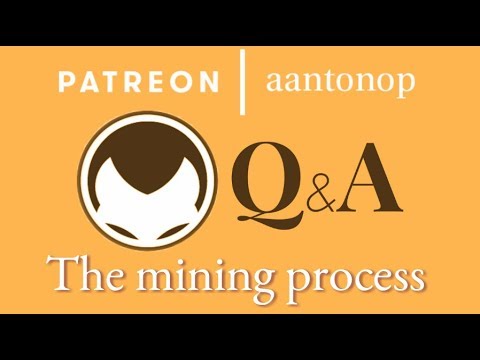Can you provide a brief overview of the mining process? Is there human intervention in mining or is it automated? What influenced the centralisation of mining and how will it decentralise again?
More on mining and consensus in ‘Mastering Bitcoin’ – https://github.com/bitcoinbook/bitcoinbook/blob/f8b883dcd4e3d1b9adf40fed59b7e898fbd9241f/ch10.asciidoc
These questions are from the MOOC 9.2, 9.3, and 9.5 sessions, which took place on February 23rd, March 2nd, and March 16th 2018 respectively. Andreas is a teaching fellow with the University of Nicosia. The first course in their Master of Science in Digital Currency degree, DFIN-511: Introduction to Digital Currencies, is offered for free as an open enrollment MOOC course to anyone interested in learning about the fundamental principles.
If you want early-access to talks and a chance to participate in the monthly live Q&As with Andreas, become a patron: https://www.patreon.com/aantonop
RELATED:
Consensus Algorithms, Blockchain Technology, and Bitcoin – https://youtu.be/fw3WkySh_Ho
Advanced Bitcoin Scripting Part 1: Transactions and Multisig – https://youtu.be/8FeAXjkmDcQ
Advanced Bitcoin Scripting Part 2: SegWit, Consensus, and Trustware – https://youtu.be/pQbeBduVQ4I
What is Consensus: Rules without Rulers – https://youtu.be/2tqo7PX5Pyc
Forkology: A Study of Forks for Newbies – https://youtu.be/rpeceXY1QBM
Bitcoin: Where the Laws of Mathematics Prevail – https://youtu.be/HaJ1hvon0E0
Software distribution security – https://youtu.be/_V0vqy046YM
What is mining? – https://youtu.be/t4p4iMqmxbQ
Miners, pools, and consensus – https://youtu.be/JHz7LM4ncLw
The rules of Bitcoin (part 1) – https://youtu.be/VnQu4uylfOs
The rules of Bitcoin (part 2) – https://youtu.be/vtIp0GP4w1E
Rules versus rulers – https://youtu.be/9EEluhC9SxE
The value of proof-of-work – https://youtu.be/ZDGliHwstM8
Could a state-sponsored 51% attack work? – https://youtu.be/KUd8ZGgm6Qo
Honest nodes and consensus – https://youtu.be/KAhY2ymI-tg
Spam transactions and Child Pays For Parent (CPFP) – https://youtu.be/t3c0E4fkSNs
Is Bitcoin a democracy? – https://youtu.be/TC3Hq76UT5g
Decentralized power, leaderless governance – https://youtu.be/E5VbDlQTPzU
Scaling, trust, and trade-offs – https://youtu.be/vCxmHwqyJWU
What is the role of nodes? – https://youtu.be/fNk7nYxTOyQ
Why running a node is important – https://youtu.be/oX0Yrv-6jVs
Lightning, full nodes, and miners – https://youtu.be/dlJG4OHdJzs
Running nodes and payment channels – https://youtu.be/ndcfBfE_yoY
What happens during a fork? – https://youtu.be/XBk8hBJ1xVo
SegWit adoption – https://youtu.be/KCsTVTRk6I4
Spam transactions and Child Pays For Parent (CPFP) – https://youtu.be/t3c0E4fkSNs
Energy consumption – https://youtu.be/2T0OUIW89II
Solar energy and mining in space – https://youtu.be/cusakcpa8AM
Bitmain and ASICBoost allegations – https://youtu.be/t6jJDD2Aj8k
Andreas M. Antonopoulos is a technologist and serial entrepreneur who has become one of the most well-known and respected figures in bitcoin.
Follow on Twitter: @aantonop https://twitter.com/aantonop
Website: https://antonopoulos.com/
He is the author of two books: “Mastering Bitcoin,” published by O’Reilly Media and considered the best technical guide to bitcoin; “The Internet of Money,” a book about why bitcoin matters.
THE INTERNET OF MONEY, v1: https://www.amazon.co.uk/Internet-Money-collection-Andreas-Antonopoulos/dp/1537000454/ref=asap_bc?ie=UTF8
[NEW] THE INTERNET OF MONEY, v2: https://www.amazon.com/Internet-Money-Andreas-M-Antonopoulos/dp/194791006X/ref=asap_bc?ie=UTF8
MASTERING BITCOIN: https://www.amazon.co.uk/Mastering-Bitcoin-Unlocking-Digital-Cryptocurrencies/dp/1449374042
[NEW] MASTERING BITCOIN, 2nd Edition: https://www.amazon.com/Mastering-Bitcoin-Programming-Open-Blockchain/dp/1491954388
Subscribe to the channel to learn more about Bitcoin & open blockchains!
Music: “Unbounded” by Orfan (https://www.facebook.com/Orfan/)
Outro Graphics: Phneep (http://www.phneep.com/)
Outro Art: Rock Barcellos (http://www.rockincomics.com.br/)
source

















12.5 bitcoins seems like a huge payday. what is the gotchas? what are satoshi's? why wouldn't every transaction be the same number of bytes?
Sehr interessant, sollten uns mal unterhalten, Liebe Grüße Thomas
Outstanding
Hello Andreas, QUESTION:
What Proof of work for Encryption, Uniqueness & Entire Control is generated by the creation of the Digital Seed by an application ?
Thank you Andreas! Bitcoin is 5 (cat) years older than the other crypto currencies, but it feels like they all caught up to Bitcoin and, because of the exponential growth, Bitcoin might end up in the top 50 in 6 months!! What is Bitcoin doing wrong?? How does it become the clear winner with the lowest fees, the highest tps and the highest number of nodes? This competition shouldn't be that close.
On Bitcoin Congress in Warsaw I asked you about plasma cash on Ethereum, one of three as it seems scalability solutions for ETH along with Casper and sharding. Seems Plasma Cash is done in cooperation with Joseph Poon (LN) so very promising. I don't know the details yet, but form what I understand it's a LN but on chain and with less potential for scaling? I wonder why this solution? Why someone like Joseph Poon would help to develop LN on chain? I I wonder what are the basic differences between LN and Plasma cash except the onchain/offchain part.
https://medium.com/novamining/plasma-cash-new-scalability-solution-for-the-ethereum-network-f7c0b889db7d
Great video Andreas! However, in spite of also having read your book, I still don't quite understand what happens to the transactions in a losing candidate block, and how and when transactions move from the mempool into a block. I would appreciate if you could explain this process in more detail.
Here's my best guess at how it goes.
Each miner can chose which and how many transactions from the mempool to include in their candidate block. So in theory at least, each candidate block could include a different set of transactions. Once a block is found, the transactions in the winning block are 'tagged' confirmed and removed from the mempool. The losing miners delete their transaction selections and start over with a new set of transactions from the current mempool of unconfirmed transactions.
Please let me know if this is correct of if I'm missing something. Thanks!
Shouldnt the mining difficult decrease with the time without blocks? Imagine that all the asic miners leave bitcoin. It would take ages to a normal pc find each block, so the difficult adjustment would take forever because it happens every x blocks. If the difficult decreased after some time without new blocks it would be easier to new miners join the network in case the asic ones change chain
In the future when bitcoin are no longer issued as a reward, will there no longer be empty blocks as there is no financial benefit?
Thank you, this is the most in depth explanation I have found yet. My remaining questions are:
1. Where does each miner get it's nonce? Does it just start at a random number? Do they all start with the same? Can you tweak it?
2. So it seems that after a block solution is found and transmitted to other nodes, how long does that process take to reach all nodes?
3. Is it possible that a few solutions can be being worked on at the same time?
4. Is it possible to ignore other miner's solutions? If not, is it then possible to flood the network with incorrect solutions and in effect create a denial of service?
5. I'm also wondering about the pool of transactions left to be added. From your video it sounds like it can just grow and grow creating a huge backlog. How do they prevent this from happening? How do they guarantee timely transactions?
6. I know they are counting on fees to ultimately provide incentive when the bitcoins that are awarded just aren't worth it. If this is so, does this means transactions without fees or smaller ones can just be pushed to the end of the line forever?
Thanks. BTW, I have heard of a team which owns 8 warehouses full of miners in China, and that was like a year ago.
Again, great video! Going to share it with friends.
I'm concerned that some day governments require KYC for transactions. Which can get the transactions to sit in queue until it gets KYC info from another protocol. That's why i really take mining decentralization seriously.
Thank you Andreas.
Chinese subtitle please
Were is mempool stored? Once a new block is mined, the transactions it contains must be removed from mempool. Right? Who preforms the removal? What if the block I am mining at the moment contains transaction X and Y, and I receive a new valid block with transactions X and Z. Should I abandon mining both of them or just the transaction X?
https://youtu.be/L4Xtau0YMJw?t=42s "Let's say it's running Bitcoin Core". Ver's remora marketing tactic apparently succeeded and now appends BCH to someones consciousness when speaking of Bitcoin.
BTC is vulnerable. As are all crypto's. There needs to be innovation in the crypto space away from current models. Too easy for bankster gangsterism to throw in piles of fiat and control big volumes. Big mines can be bought up by bad actors who can use the reward coins in manipulative attacks as well as the coins they buy with their fiat. The exchanges are obviously a vulnerability as well. Combine these facts and it is not hard to reconcile that control has now been taken over by the same thugs who have controlled money for hundreds of years. (to some extent , and that will no doubt increase as we move forward in time) I have a new coin architecture that I need a pro's help on. Best regards Mr. Antonopolous
thx for upload <3
Wouldn't Bitcoin be more decentralized with an ASIC resistant mining algorithm?
Is the nonce calculated in a sequential order or random sequence? Because I was wondering if everybody is incrementing the nonce say from zero upwards till they find a valid hash. Because another advantage of having a large amount of miners could be starting different miners at different starting points so they aren't all counting the same nonce numbers
Andreas, would you be interested in spanish subtitles for your videos?
@aantonop – What would be the logical incentive for someone to start an LND node, Satoshi put his trust on humans doing good primarily for themselves, so how would this translate into Lightning growing and spreading if there is no monetary incentive?
@ decentralization: true, BUT one (a few) miner(s) can (and will very probably) globalize their mining activities => decentralized mining facilities, but centralized decision making…
best explination always…..smashed the like…..
I haven't got any crypto currency however I am fascinated with the technology and community.
but those few taht have a lot of percent of the hash power are the pools right? So when people see a pool doing something they dont agree with can choose to use another pool?
Fitrova FRV token Listed in 3 exchanges after the 2 weeks of ICO complete, and 2 more exchanges in coming week. Best token for health and fitness industry.